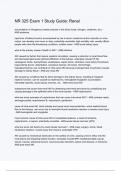NR 325 Exam 1 Study Guide: Renal
accumulation of nitrogenous waste products in the blood (urea, nitrogen, creatinine, etc.) -
ANS-azotemia
rapid loss of kidney function accompanied by rise in serum creatinine and/or reduction in urine
output, can develop over hours or days. potentially reversible. high mortality rate. usually effects
people with other life-threatening conditions. sudden onset - ANS-acute kidney injury
what is the primary cause of death in AKI? - ANS-infection
AKI caused by factors that reduce systemic circulation, causing a reduction in renal blood flow
and decreased glomerular perfusion/filtration of the kidneys. examples include HF, MI,
cardiogenic shock, dysrhythmias, anaphylaxis, septic shock, embolism, renal artery thrombosis,
hypovolemia (burns, dehydration, excessive diuresis, GI losses, hemorrhage,
hypoalbuminema). can contribute to intra-renal AKI because prolonged lack of perfusion causes
damage to kidney tissue - ANS-pre-renal AKI
AKI caused by conditions that do direct damage to the kidney tissue, resulting in impaired
nephron function. can be caused by nephrotoxins, hemoglobin/myoglobin accumulation,
interstitial nephritis, acute tubular necrosis, etc. - ANS-intra-renal AKI
substances that cause intra-renal AKI by destroying intra-renal structures by crystallizing and
causing damage to the epithelial cells of the renal tubules - ANS-nephrotoxins
what are some examples of nephrotoxins that can cause intra-renal AKI? - ANS-contrast media,
aminoglycosides, amphotericin B, vancomycin, gentamicin
cause of intra-renal AKI, block tubules and cause renal vasoconstriction, which restricts blood
flow to the kidneys. can occur due to hemolytic blood transfusion reaction or severe crush injury
- ANS-hemoglobin and myoglobin
most common cause of intra-renal AKI in hospitalized patients. a result of ischemia,
nephrotoxins, or sepsis. potentially reversible - ANS-acute tubular necrosis (ATN)
what are some risk factors for acute tubular necrosis? - ANS-major surgery, shock, blood
transfusion reaction, muscle injury from trauma, prolonged HTN
AKI caused by mechanical obstruction in the outflow of urine, causing urine to reflux into the
renal pelvis and impairing kidney function. examples include BPH, bladder/prostate cancer,
stones, trauma, extrarenal tumors, neuromuscular disorders, spinal cord disease, or strictures -
ANS-post-renal AKI
,phase of AKI that occurs within 1-7 days of kidney injury and can last 2 weeks to several
months. characterized by reduction of urine output less than 400 mL/day. accumulation of
potassium can cause hyperkalemia - ANS-oliguric phase
phase of AKI that lasts 1-3 weeks. urine output increases as the cause of AKI is treated
because osmotic diuresis occurs due to the high concentration of the urea in the glomerular
filtrate. the kidneys can excrete wastes but are still not functioning well enough to concentrate
the urine - ANS-diuretic phase
phase of AKI that can take up to 12 months to occur. not everyone with AKI reaches this stage.
begins when GFR starts to increase, which allows BUN and creatinine levels to be decreased
through urine output - ANS-recovery phase
what are some clinical manifestations of AKI during the oliguric phase? - ANS-oliguria,
casts/WBCs in urine, urine specific gravity fixed at 1.010, urine osmolality same as plasma
(300), proteinuria, hyperkalemia, hyponatremia, increased BUN/creatinine, fluid retention,
metabolic acidosis, leukocytosis, neurologic changes
what is the best serum indicator of AKI? - ANS-creatinine
what are some clinical manifestations of the diuretic phase of AKI? - ANS-increased urine
output, hypovolemia, hypotension, dehydration, hyponatremia, hypokalemia
progressive, irreversible los of kidney function, much more common than AKI, patients often
asymptomatic, prognosis/course highly variable. presence of kidney damage or GFR less than
60 for longer than 3 months - ANS-chronic kidney disease (CKD)
what are the leading causes of CKD? - ANS-DM, HTN
what are some risk factors for CKD? - ANS-HTN, increased age, obesity, CV disease, DM,
African American, nephrotoxic drug exposure, family history
what is the most common cause of death in patients with CKD? - ANS-CVD (MI, ischemic heart
disease, PAD, HF, cardiomyopathy, stroke)
stage of CKD in which there is kidney damage with normal kidney function. GFR is 90 or higher.
- ANS-stage 1
stage of CKD in which there is kidney damage with mild los of kidney function. GFR is 60-89 -
ANS-stage 2
stage of CKD in which there is mild to moderate loss of kidney function and the GFR is 30-59 -
ANS-stage 3
, stage of CKD in which there is severe loss of kidney function. GFR is 15-29 - ANS-stage 4
stage of CKD in which kidneys have failed and patient is in end-stage renal disease. GFR is
less than 15. dialysis/transplantation needed for survival - ANS-stage 5
what is the main test used to identify the stage of CKD? - ANS-eGFR
syndrome that occurs in CKD where kidney function declines to the point that symptoms
develop in multiple body systems. often occurs when GFR is 15 or less - ANS-uremia
what are some metabolic effects of CKD? - ANS-increased BUN, serum creatinine, blood
glucose, insulin levels, VLDL, LDL, and triglycerides. decreased HDL, impaired
carbohydrate/glucose metabolism
what are some electrolyte/acid-base effects of CKD? - ANS-hyperkalemia, dilutional
hyponatremia, sodium retention, hypermagnesemia, hypocalcemia, hyperphosphatemia,
metabolic acidosis
hematologic effect of CKD that occurs because of decreased production of erythropoietin by the
kidneys, nutritional deficiencies, decreased RBC life span, increased RBC hemolysis, frequent
blood samplings, GI bleeding, and increased parathyroid hormone - ANS-anemia (normocytic,
normochromic)
what are some hematologic effects of CKD? - ANS-anemia, iron deficiency, folic acid deficiency,
bleeding, increased susceptibility to infection
is increased in patients with CKD, inhibits RBC synthesis, shortens survival of RBCs, and
causes bone marrow fibrosis, all contributing to anemia - ANS-parathyroid hormone
important for RBC maturation, patients on dialysis need supplementation because it is water
soluble and therefore dialyzable - ANS-folic acid
what is the most common cause of bleeding in patients with CKD? - ANS-defect in platelet
function (impaired release of platelet factor III)
what are some cardiovascular effects of CKD? - ANS-HTN, HF, CAD, pericarditis, PAD,
dysrhythmias
what is one of the most important therapeutic goals in CKD management? - ANS-BP control
what are some respiratory effects of CKD? - ANS-Kussmaul respirations, dyspnea, pulmonary
edema, uremic pleuritis, pneumonia




